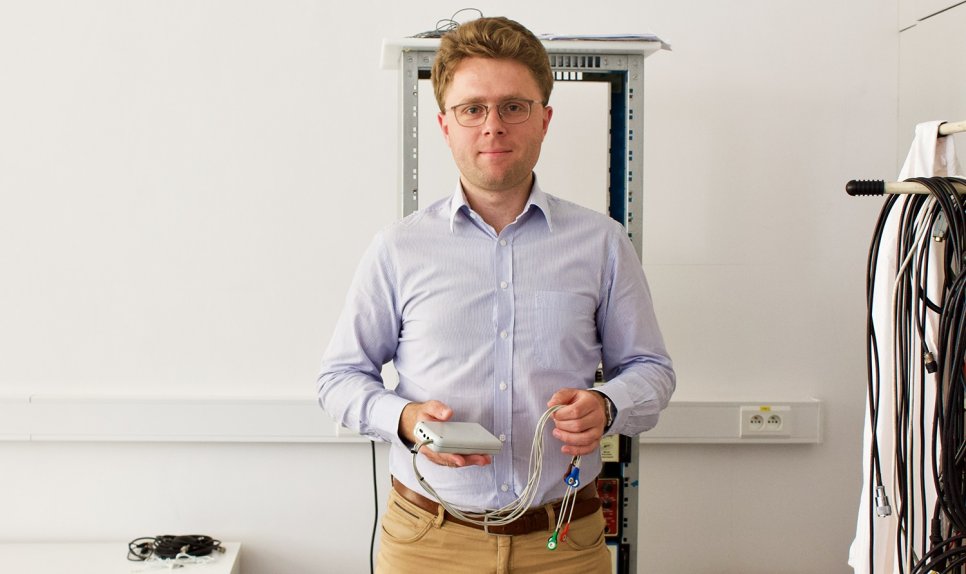Simultaneous measurement of breath, heart rate and physical activity
How is it possible?
At the Faculty of Mechatronics at the WUT, a Pneumonitor was created, which allows to monitor the frequency and depth of breathing and also to associate these with the variability of the heart rhythm or the physical activity of the examined person. This is the first such "mobile" solution designed for long-term observation.
The development of the device was coordinated by Marcel Młyńczak, PhD Eng, who studies and analyzes physiological signals, in particular respiration. He has been working on the Pneumonitor since his university studies. – As a member of the scientific circle, I participated in a meeting with doctors of various specializations in one of the Warsaw hospitals. We discussed their needs. At that time, I prepared notes, to which I returned at the stage of choosing my bachelor’s thesis – recalls the researcher. "My thesis supervisor and I discussed how some of these ideas could be implemented. Pneumonitor is, in a way, the fruit of this conversation. Later, I developed the device and analytical methods in my master's thesis and as part of my doctorate – he adds.
There are many advantages to it
The advantage of the device is primarily its non-invasiveness. The electrodes are glued so that they do not affect the freedom of movement. The measurement method itself is also an asset. – We do not perform point measurement, i.e. assessment of one exhaust (as in spirometry), we can record physiological signals 24 hours a day, also outside the hospital environment – emphasizes Marcel Młyńczak, PhD Eng.
The pneumonitor allows for the measurement of respiratory activity without the need for a special mask.
– Owing to this, the measurement is more convenient and does not disturb the breathing space around the mouth and nose – says Marcel Młyńczak, PhD Eng. – Additionally, we have the possibility of linking respiratory activity with parameters describing the variability of heart rhythm or the position of the body and the level of effort of the examined person – he emphasizes. – Besides, when the doctor performs spirometry, he does not perform an ECG and vice versa. The device allows you to perform both tests at the same time. This is a process innovation – he adds.
How does it work?
The electrodes are stuck under the armpits and on the hands to fully cover the lungs. They can also be placed as part of a patch stuck to the chest (so-called patch). The pneumonitor uses the impedance pneumography method. – We measure changes in electrical impedance in the chest, that is, we observe changes in the variation of electrical resistance in the tissues of the chest. Simply put, if there is more air in the lungs, that is, we are after the inhalation phase, then the impedance is greater, and if there is less air, then the impedance is correspondingly lower. We can see the waveform of impedance changes under the influence of breath – says Marcel Młyńczak, PhD Eng.
Not only patients
The solution is addressed to doctors, but it was created, of course, for their patients and not only. – Nowadays, we primarily want to take long-term measurements of both respiratory and cardiac activity. Due to this, we will be able to prepare a cardiopulmonary profile, which would consist of a group of biomarkers dependent on the target group. We think primarily about the elderly, people with cardiac problems or respiratory allergies, but also athletes preparing for the competition – explains Marcel Młyńczak, PhD Eng.
What is next?
The current version of the device fulfills all the target functions, while it was made "manually", e.g. using the casing available on the market. Marcel Młyńczak, PhD Eng., is thinking about preparing a pre-production version, which in the case of a larger order could be copied in an automated manner. For this, however, funds are required.
– I plan to submit an application in the SONATA competition organized by the National Science Centre – announces Marcel Młyńczak, PhD Eng. The researcher would also like the next version of the device to be more miniaturized and even more convenient to use. There are plans to create an application that will enable doctors, trainers, athletes and patients to easily and quickly use the database collected using the Pneumonitor.
Additional resources would also make the device available to a larger group of athletes and trainers. – For several years I have been cooperating with the Central Sports Medicine Centre, which examines a large group of Olympians, especially the participants of the summer games. They come specially to Warsaw for tests, which is often inconvenient. The research is scored, and after that, the athletes go home. There is no added value here – explains Marcel Młyńczak, PhD Eng.
The Pneumonitor could be used anywhere with the possibility of linking the results to a training program or other sports results. The aim is to correlate cardio-respiratory parameters with their sports form and provide trainers with information on how to possibly modify training so that the upward trend is optimal to hit the championship form at the right time, i.e. the Olympic Games.
– This is the moment when, in substance, everything is done, the device operates functionally, but financial resources are needed to take the next step – admits Marcel Młyńczak, PhD Eng.









